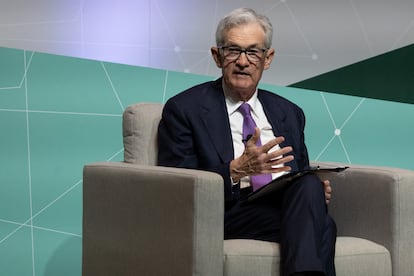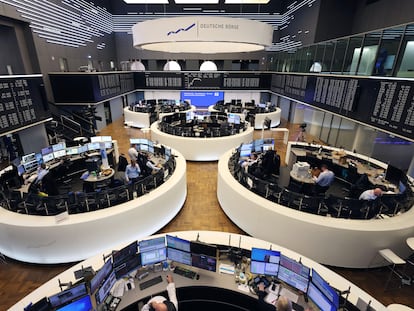Powell demands respect for the Fed’s independence amid US presidential campaign
The chair of the American central bank said that he has ‘peace of mind’ because he knows decisions on interest rates are based strictly on economic criteria


In the crossfire of political pressures, the chair of the U.S. Federal Reserve, Jerome Powell, is being forced to emphasize the obvious: the independence of the central bank. It is a topic that he recently addressed at an event in San Francisco, and on which he focused a good part of his speech at Stanford University on Wednesday. The turning point for monetary policy has coincided with an election year, as the campaign for the November 5 presidential election gets underway. By calling for the Fed’s independence to be respected, Powell wants to make it clear that he will not be influenced by political calculations when it comes to the decision to start lowering interest rates.
“In the case of the Federal Reserve, independence is essential to our ability to serve the public. The record shows that independent central banks deliver better economic outcomes,” Powell said. The chair of the central bank recalled that to achieve the double objective of maximum employment and price stability, Congress granted the Federal Reserve a high degree of independence with respect to its monetary policy decisions.
“Fed policymakers serve long terms that are not synchronized with election cycles. Our decisions are not subject to reversal by other parts of the government, other than through legislation. This independence both enables and requires us to make our monetary policy decisions without consideration of short-term political matters,” Powell stressed.
Democrats want Powell to lower rates as soon as possible, although the president, Joe Biden, has been highly respectful of his independence. This is in contrast to Donald Trump, who has accused Powell — without any basis — of supporting Biden’s bid for re-election: “I think he’s going to do something to probably help the Democrats, I think, if he lowers interest rates,” Trump said in February. The Republican has warned that if he wins the November election, he would not renew Powell’s mandate. Powell took over as chair of the Federal Reserve in 2018 after being appointed by Trump. In 2022, under President Biden, he was sworn in for a second term, which comes to an end in May 2026.
The chair of the Federal Reserve admitted Wednesday that independence is an exceptional concession and that, therefore, he needs to earn it every day. “We do so by carrying out our work with technical competence and objectivity, in a transparent and accountable manner, and by sticking to our knitting,” said Powell, who made it clear that he should not act on issues that could be relevant to the economy but do not fall within his mandate, such as particular tax and spending policies, immigration policy, trade policy, or climate policy.
No hurry to lower rates
Powell has not added anything new to his message regarding the Fed’s recent decisions. “The job of sustainably restoring 2% inflation is not yet done,” he insisted, reiterating the message that the central bank does not believe it is appropriate to lower the official interest rate until it has greater confidence that inflation is moving sustainably down toward that target.
“Given the strength of the economy and progress on inflation so far, we have time to let the incoming data guide our decisions on policy,” said Powell, who on Friday made it clear that there was no rush to lower rates. “If the economy evolves broadly as we expect, most FOMC [the committee in charge of monetary policy] participants see it as likely to be appropriate to begin lowering the policy rate at some point this year.”
In his speech, he noted that the latest data does not “materially change the overall picture” and that, “on inflation, it is too soon to say whether the recent readings represent more than just a bump.”
Members of the Federal Open Market Committee expect interest rates to drop 0.75 points by the end of the year from the current 23-year high of 5.25%-5.5% to reach 4.625% (that is, in the 4.5%-4.75% range), according to forecasts updated two weeks ago. However, nine of the 19 members of the committee expect a somewhat smaller reduction, so the three cuts largely expected by the market are by no means guaranteed.
In fact, recent messages have all but ruled out an interest rate cut at the Federal Reserve meeting on May 1, and attention is shifting to the last meeting of spring, on June 11-12. But there is no certainty that any move will be made then either. Powell has insisted time and again that the decision will depend on additional data.
Although Powell is under pressure in the polarized political environment of the United States, it is not unusual for the Federal Reserve to raise or lower rates during an election year if it is considered necessary. The Fed lowered them in 2020 due to the pandemic and in 2008 due to the financial crisis. There were rate hikes in 2000 and 2004 to address the tech and real estate bubbles, respectively.
On Wednesday, Powell once again stated that the Federal Reserve will be guided strictly by economic criteria. “Internally, we have peace of mind on this because everybody who works at the Fed knows that we’re going to do what we’re going to do, and we’re going to do it for economic reasons,” he stressed in the questions after his speech. “If you look at the modern historical record, you’ll see that the Fed has been prepared to move or not move and do what it thinks is the right thing for the economy in the medium and longer term, without regard to outside considerations. And it’s important to just have people know that, which is why I brought it up. [...] My colleagues and I are tightly focused on that.”
Sign up for our weekly newsletter to get more English-language news coverage from EL PAÍS USA Edition
Tu suscripción se está usando en otro dispositivo
¿Quieres añadir otro usuario a tu suscripción?
Si continúas leyendo en este dispositivo, no se podrá leer en el otro.
FlechaTu suscripción se está usando en otro dispositivo y solo puedes acceder a EL PAÍS desde un dispositivo a la vez.
Si quieres compartir tu cuenta, cambia tu suscripción a la modalidad Premium, así podrás añadir otro usuario. Cada uno accederá con su propia cuenta de email, lo que os permitirá personalizar vuestra experiencia en EL PAÍS.
¿Tienes una suscripción de empresa? Accede aquí para contratar más cuentas.
En el caso de no saber quién está usando tu cuenta, te recomendamos cambiar tu contraseña aquí.
Si decides continuar compartiendo tu cuenta, este mensaje se mostrará en tu dispositivo y en el de la otra persona que está usando tu cuenta de forma indefinida, afectando a tu experiencia de lectura. Puedes consultar aquí los términos y condiciones de la suscripción digital.
More information
Archived In
Últimas noticias
Most viewed
- Sinaloa Cartel war is taking its toll on Los Chapitos
- Oona Chaplin: ‘I told James Cameron that I was living in a treehouse and starting a permaculture project with a friend’
- Reinhard Genzel, Nobel laureate in physics: ‘One-minute videos will never give you the truth’
- Why the price of coffee has skyrocketed: from Brazilian plantations to specialty coffee houses
- Silver prices are going crazy: This is what’s fueling the rally









































